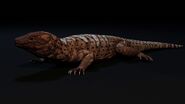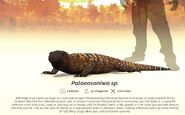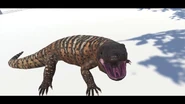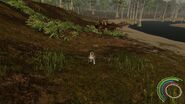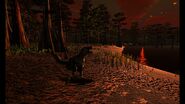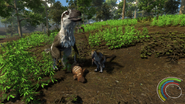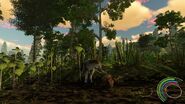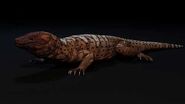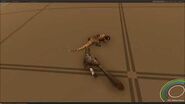"Although it can grow as large as a komodo dragon, Palaeosaniwa (Ancient Saniwa) is actually an early relative of the modern Gila Monster (Monstersauria). Like its modern relatives, Palaeosaniwa is venomous, but this feature is used for defence more than prey capture, latching onto threats with its hooked teeth while glands on the lower jaw excrete venom into the wound. This animal acts primarily as a specialized raider of dinosaur nests, making Palaeosaniwa a primary enemy of hatchling-stage dinosaurs and protective parents."
― Saurian encylopedia
Palaeosaniwa was an extinct genus of carnivorous lizard from the late Cretaceous of North America. The name, given by Charles Whitney Gilmore in 1928, means "ancient Saniwa from Canada", Saniwa being an extinct genus of the monitor lizard family.
Measuring around 2 - 3.5 m (6.5 - 11.5 ft) in length, it was among the largest terrestrial lizards known from the Mesozoic period (though Asprosaurus may compete with it in size).
Palaeosaniwa's teeth were sharp and flattened like blades, with small serrations along the edges, indicating it was a carnivore. Palaeosaniwa fed on small vertebrates, including mammals and other reptiles, like small dinosaurs including the youngsters of larger species. Palaeosaniwa itself was likely prey to the predatory dinosaurs it shared its habitat with.
Palaeosaniwa is a member of the Anguimorpha, a group that includes the monitor lizards (Varanidae) and Gila monsters (Helodermatidae), as well as some other species of lizards, such as knob-scaled lizards and slow worms. This could mean it might have had venom similar to that of a Komodo dragon or Gila monster. Originally, it was thought to be a member of the Varanidae, but has also been interpreted as a relative of the Helodermatidae. The most recent analysis places Palaeosaniwa outside of either Varanidae or Helodermatidae, although still under debate.
In Saurian []

Palaeosaniwa at the feet of a Dakotaraptor
"Palaeosaniwa have venomous bites. When poisoned your health meter will pulse. The frequency of the pulse indicates how much the venom is hurting you -- stay well-fed and hydrated to counteract it."
― Saurian help icon, displayed when the player is bitten by a Palaeosaniwa
It is portrayed looking very similar to a Gila monster, with thick, warty scales and a black and bright orange color palette. Palaeosaniwa is one threat to the player while they are young, as its diet includes young or small dinosaurs. It is able to sprint a little bit, and buffs the player with intimidating sounds. If the player gets bitten by this lizard, the inflicted effects of the venom can lead to the player's death, if it isn't careful. Palaeosaniwa will likely charge and try to kill the player when young, but will prefer buffing the player as an adult, avoiding attacks. The venom usually only kills the player if they are very young or if they are damaged, that is, the player must be older and stay hydrated and well fed to survive. Paleosaniwa currently don't have sexual dimorphism or ontogenic stages.
Dakotaraptor gameplay[]
Palaeosaniwa are risky as a hatchling or juvenile Dakotaraptor. Subadults and adults can be damaged by their venom, but usually taking one down is easier, if you avoid the bites.
Triceratops gameplay[]
Palaeosaniwa are dangerous predators for hatchling Triceratops, so they must stay away from their reach. Starting from the juvenile stage you already start to get too big to be a viable prey for the lizard, but the venom may still be dangerous. As you advance to subadult and the adult stage, Palaeosaniwa venom may no longer be a threat.

